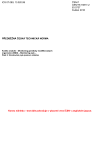ČSN P CEN/TS 16817-2 (835737)
Kvalita ovzduší - Monitoring geneticky modifikovaných organismů (GMO) - Monitoring pylu - Část 2: Vzorkování pylu pomocí včelstev
Anotace obsahu normy
This Technical Specification describes a procedure through which pollen - in particular pollen of genetically modified organisms (GMO) - can be sampled by means of bee colonies.
Bee colonies, especially the foraging bees, actively roam an area and are therefore area related samplers. Pollen sampling depends on the collection activity of the bees and the availability of pollen sources within the spatial zone according to the bees' preferences (supply of melliferous plants). A colony of bees normally forages over an area of up to 5 km radius (median 1,6 km, mean 2,2 km), in rare cases some bees may also forage in greater distances up to 10 km and more [26].
Foragers fix the gathered pollen on the outside of their hind legs (pollen loads, also known as pollen pellets). Inside the hive they place these pollen loads into comb cells close to the brood nest (bee bread). Furthermore, foragers gather nectar and honeydew. Nectar contains pollen which fell from the anthers of the blossom into the nectar drop, or pollen which was dispersed by the wind and sticks in the nectar of other blossoms or adheres to the sticky honeydew of plants. Nectar and honeydew are converted to honey and stored by the bees in the beehive.
Honey, pollen load and bee-bread may be used as sample matrices for the subsequent analysis of pollen as it is possible to concentrate sufficient amounts of pollen for microscopic and molecular biological diagnostics.
Microscopic analysis is used to identify the various pollen types and to quantify the exposure to the target pollen types in question. GMO exposure is analysed by molecular-biological methods: For analysis of pollen DNA quantitative PCR methods are used and described here in this Technical Specification. The analysis of GMO specific proteins and toxins in pollen is possible, too, using ELISA, but to this date the method has not been evaluated enough in pollen matrices for standardization in this Technical Specification.
| Označení | ČSN P CEN/TS 16817-2 (835737) |
|---|---|
| Katalogové číslo | 99427 |
| Cena | 350 Kč350 |
| Datum schválení | 1. 5. 2016 |
| Datum účinnosti | 1. 6. 2016 |
| Jazyk | angličtina (obsahuje pouze anglický originál) |
| Počet stran | 36 stran formátu A4 |
| EAN kód | 8590963994277 |
| Dostupnost | skladem (tisk na počkání) |
Další příbuzné normy
ČSN P CEN/TS 16817-1 (835737)
Kvalita ovzduší - Monitoring geneticky modifikovaných organismů (GMO) - Monitoring pylu - Část 1: Vzorkování pylu pomocí pylového filtru (PMF) a vzorkovacího zařízení Sigma-2


